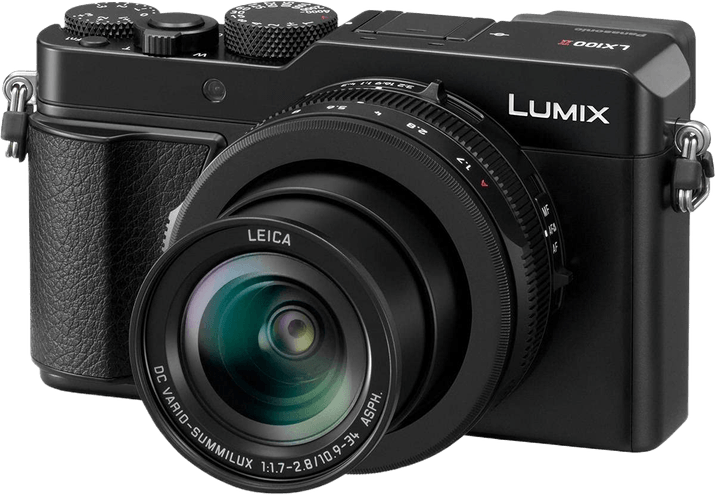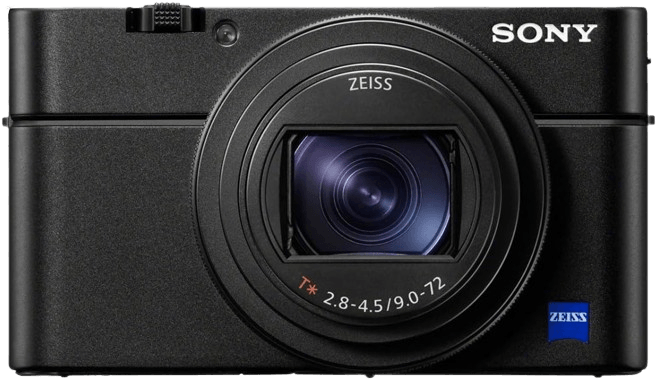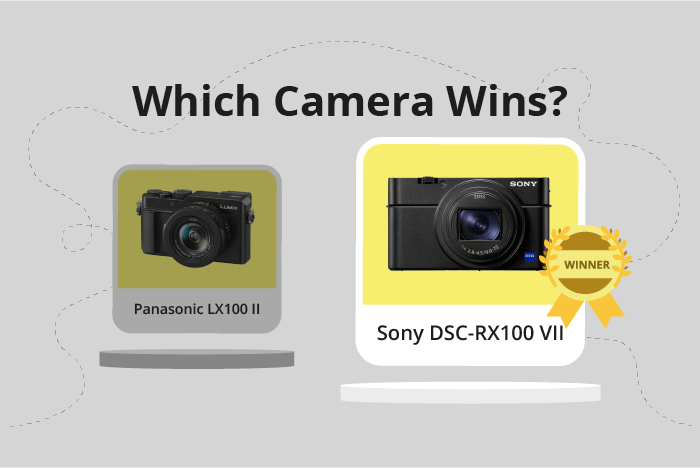Panasonic Lumix LX100 II vs Sony Cyber-shot DSC-RX100 VII Comparison
Panasonic Lumix LX100 II

Sony RX100 VII

The Panasonic Lumix LX100 II and the Sony Cyber-shot DSC-RX100 VII both have a score of 60/100, indicating a tie in our comparison. These compact cameras share similarities, including announcement dates in 2018 and 2019 and launch prices of $999 and $1200, respectively.
The Lumix LX100 II has advantages in size and weight, measuring 115 x 66 x 64mm and weighing 392g, making it slightly larger but more substantial than the RX100 VII. This may provide a better grip and stability for some users.
On the other hand, the Cyber-shot DSC-RX100 VII is smaller and lighter at 102 x 58 x 43mm and 302g. This could be a better option for those seeking a more portable and lightweight camera.
Considering these factors, the choice between the two cameras depends on individual preferences for size and weight. Both cameras offer quality performance, but the Lumix LX100 II may be better for users who prefer a larger camera, while the RX100 VII caters to those who value portability.
Panasonic Lumix LX100 II vs Sony Cyber-shot DSC-RX100 VII Overview and Optics
The Sony Cyber-shot DSC-RX100 VII wins the optics comparison with a score of 61/100, while the Panasonic Lumix LX100 II scores 58/100. Both cameras share common features such as CMOS sensors, fixed lens mounts, and image stabilization. They also have different processors, with the Lumix LX100 II using the Venus Engine and the RX100 VII using the Bionz X.
The RX100 VII outperforms the LX100 II in terms of megapixels, offering 20 compared to the LX100 II’s 17. This means the RX100 VII can capture more detail and produce higher resolution images. Additionally, the RX100 VII has a 3:2 aspect ratio, which is more suitable for printing photographs, while the LX100 II has a 4:3 aspect ratio.
On the other hand, the LX100 II has a higher DXOMARK sensor score of 71, compared to the RX100 VII’s 63. This indicates that the LX100 II’s sensor performs better in terms of color depth, dynamic range, and low light performance. Furthermore, the LX100 II has a faster shooting speed of 11 frames per second, compared to the RX100 VII’s 5 frames per second. This makes the LX100 II more suitable for capturing fast-moving subjects and action photography.
The LX100 II also has a Micro Four Thirds sensor, which is larger than the RX100 VII’s 1″ sensor. This results in better image quality and improved low light performance.
After comparing the optics of both cameras, it is clear that the Sony RX100 VII is the better choice for those who prioritize higher resolution images and a more suitable aspect ratio for printing. However, the Panasonic LX100 II offers better sensor performance, faster shooting speed, and a larger sensor size, making it a strong contender for action photography and low light situations.
Panasonic Lumix LX100 II vs Sony Cyber-shot DSC-RX100 VII Video Performance
The Sony Cyber-shot DSC-RX100 VII outperforms the Panasonic Lumix LX100 II in video capabilities, with a video score of 91/100 compared to the LX100 II’s score of 69/100. Both cameras share some similarities in their specifications, such as 4K maximum video resolution and maximum video dimensions of 3840 x 2160.
The RX100 VII excels over the LX100 II in several areas. Firstly, it has a higher maximum video frame rate of 120fps, compared to the LX100 II’s 60fps. This allows for smoother and more detailed slow-motion footage. Additionally, the RX100 VII has built-in time-lapse functionality, which the LX100 II lacks. This feature enables users to create stunning time-lapse sequences without the need for additional software or equipment.
While the LX100 II does not have any clear advantages over the RX100 VII in terms of video capabilities, it still offers decent video performance with its 4K resolution and 60fps frame rate. These features are sufficient for most casual users and amateur videographers looking to capture high-quality footage.
Taking these factors into account, the Sony Cyber-shot DSC-RX100 VII emerges as the superior camera for video capabilities, thanks to its higher video frame rate and built-in time-lapse functionality. The Panasonic Lumix LX100 II, although not as advanced, still provides satisfactory video performance for those who prioritize other features and are not heavily focused on video production.
Panasonic Lumix LX100 II vs Sony Cyber-shot DSC-RX100 VII Features and Benefits
The Panasonic Lumix LX100 II wins in the features comparison with a score of 70/100, while the Sony Cyber-shot DSC-RX100 VII scores slightly lower at 68/100. Both cameras share several specifications, including a 3-inch screen size, touchscreen capability, absence of GPS, and the presence of WIFI and Bluetooth connectivity.
The Lumix LX100 II outperforms the Cyber-shot DSC-RX100 VII in screen resolution, boasting 1,240,000 dots compared to the Sony’s 921,000 dots. This higher resolution provides clearer and more detailed image previews and better menu navigation on the LX100 II.
On the other hand, the Sony Cyber-shot DSC-RX100 VII has a flip screen, a feature absent in the Panasonic Lumix LX100 II. This flip screen allows for more versatile shooting angles and is particularly useful for vlogging or taking selfies.
Comparing the features of both cameras, the Panasonic Lumix LX100 II’s higher screen resolution gives it an edge in image preview and menu navigation. Meanwhile, the Sony Cyber-shot DSC-RX100 VII’s flip screen offers greater flexibility in shooting angles. The choice between these two cameras will depend on the individual’s specific needs and preferences. If a higher screen resolution is a priority, the Lumix LX100 II is the better option. However, if versatility in shooting angles is more important, the Cyber-shot DSC-RX100 VII will be the more suitable choice.
Panasonic Lumix LX100 II vs Sony Cyber-shot DSC-RX100 VII Storage and Battery
The Panasonic Lumix LX100 II outperforms the Sony Cyber-shot DSC-RX100 VII in storage and battery, scoring 35/100 compared to Sony’s 29/100. Both cameras share similarities in storage capabilities, each featuring one memory card slot and compatibility with SD, SDHC, and SDXC cards. Additionally, both cameras have USB charging.
The Lumix LX100 II surpasses the RX100 VII in battery life, offering 340 shots per charge compared to Sony’s 260 shots. Therefore, the Panasonic camera provides users with longer shooting sessions before needing a recharge. The Sony RX100 VII, however, accepts Memory Stick Pro Duo cards in addition to the standard SD options, granting users more versatility in storage choices.
In terms of storage and battery, the Panasonic Lumix LX100 II proves to be the superior choice due to its longer battery life. While the Sony RX100 VII offers more storage options, it falls short in battery performance, making the Lumix LX100 II the better camera in this aspect.
Alternatives to the Panasonic Lumix LX100 II and Sony Cyber-shot DSC-RX100 VII
Are you still undecided about which camera is right for you? Have a look at these popular comparisons that feature the Panasonic Lumix LX100 II or the Sony Cyber-shot DSC-RX100 VII:
- Ricoh GR IIIx vs Sony Cyber-shot DSC-RX100 VII
- Canon PowerShot G7 X Mark III vs Sony Cyber-shot DSC-RX100 VII
- Canon PowerShot G5 X Mark II vs Sony Cyber-shot DSC-RX100 VII
- Panasonic Lumix DMC-LX100 vs Lumix LX100 II
- Panasonic Lumix ZS200 (TZ200) vs Sony Cyber-shot DSC-RX100 VII
- Canon PowerShot G1 X Mark III vs Sony Cyber-shot DSC-RX100 VII

